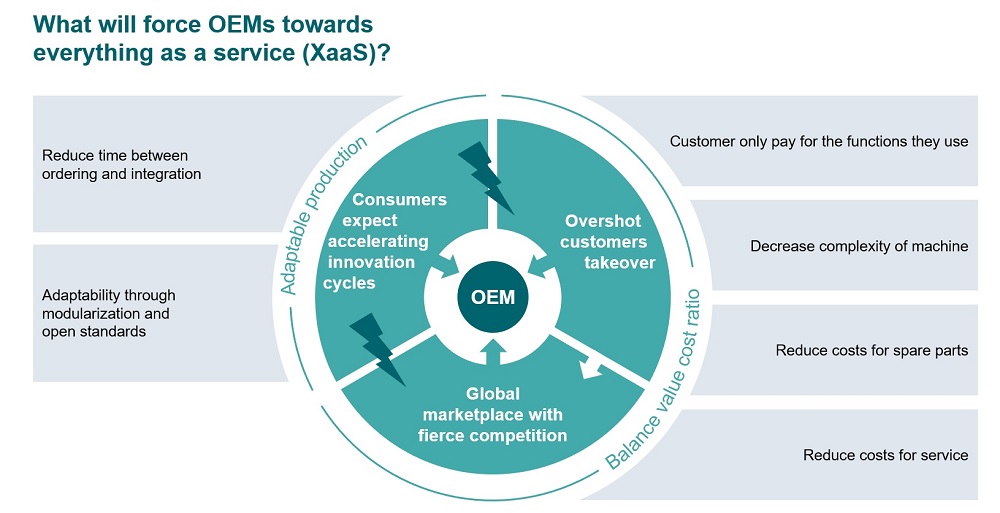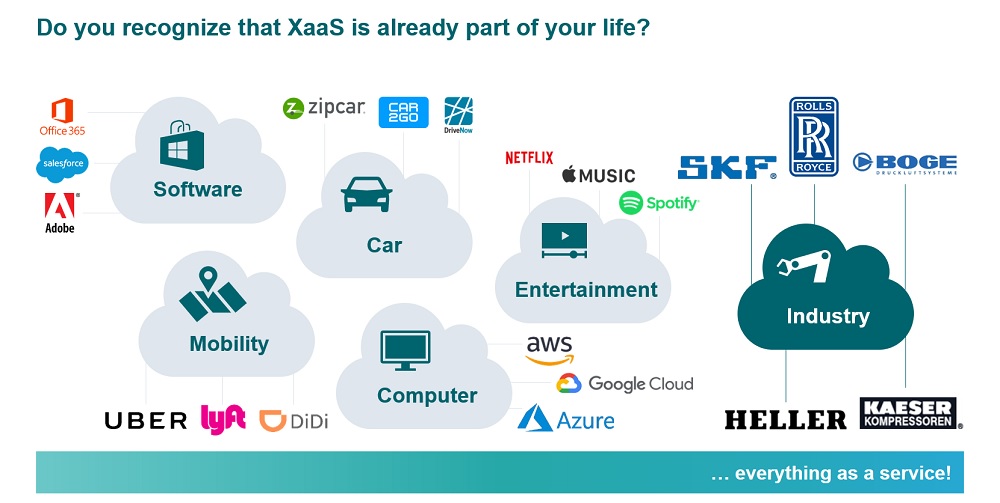Everything as a service: a closer look at the business model of the future

Everything as a service is increasingly becoming the preferred business model. Thanks to major platforms like Uber for ridesharing, Netflix for streaming video and Google for cloud services, businesses are now seeing the benefits of embracing on-demand, ‘as a service’ business models.
Everything as a service uses X as a placeholder for any kind of product, meaning that you don’t sell the product itself but charge for the usage or the output of the product, such as pay-per-use or a monthly flat fee, like Uber or Netflix, respectively. In financial terms, the customer exchanges capital expenses for operational expenses. Although XaaS sounds like it’s a standard leasing or renting model, that is not the case.
The concept isn’t new, either. Sixty years ago, the Xerox Corporation (at the time named Haloid) introduced a new business model to encourage affordable widescale use of their copy machines to offices by leasing their machines. Xerox would supply the machine, services and support allowing companies a specific number of copies included in this service and charging for usage above and beyond that amount.
Today, anything as a service business models are based on the supplier taking on the responsibility for the data analysis and maintenance of the service and using information via the Internet of Things (IoT) to provide real-time upgrades and improvements.
Rolls Royce is an early adopter of the XaaS model with its turbine engines, which charges aerospace customers a fixed price for the number of hours they fly. Maintenance is covered, engine downtime is reduced, and companies have a fixed, predictable cost. These engines also come loaded with IoT sensors. For example, the Pratt & Whitney’s Geared Turbo Fan (GTF) engine is fitted with 5,000 sensors that generate up to 10 GB of data per second. As the cloud and IoT become more widely available to a much broader audience, XaaS becomes a central pillar in transforming their business.

One of the key factors driving the adoption of the everything as a service business model is what’s known as the overshot customer. The customer, from independent consumer to industrial manufacturing companies, are purchasing products that are too expensive or too complex for its purposes. 80 percent of the customers use just 20 percent of the functionality of a product. Most customers have expressed that they would accept less functionality if the machine or the product was significantly cheaper.
This is causing more pressure on the markets to meet customer demands as companies try to balance against the value and the price. Decreasing complexity, a reduction in spare parts cost and a reduction in service costs are all factors used in minimizing the cost of the service while still providing the functionality that the customer needs.
A contradiction exists, though. More and more customers demand shorter innovation cycles. This not only increases the complexity of the product but raises the cost as well. Digitalization and digital twin capabilities can provide the edge for adaptable production, allowing the producer to exchange things faster that produce different products. The whole process from end-to-end must be synchronized. For example, that can mean reducing the time between ordering and integration; from the time a company receives information over a website through the delivery of the machine, getting it ready for production and integrating it into the whole process.
The machine itself must be adaptable either through modularization or offering open standards, such as using a digital twin to engineer the product before integration begins.
A successful everything as a service business model must do the following:
- Avoid downtimes. If the machine isn’t capable of working 24/7 or you can’t deliver it on time, you lose money. Predicting failures can help machine builders know when something may likely need maintenance or repairs, including access to spare parts.
- Improve service efficiency. This is a point where you either gain or lose money. Parts and service experts must be available to manage any issues and ensure the machine has minimal downtime or updated functionality
- Performance financing approach. Ideally, XaaS will have as flexible model as pay-per-use, which means you pay for what has been used from the machine. This will also determine current usage and the value of the service.
- Positive user experience. When selling service, the retention rate must be considered high in order to achieve success. Interfaces need to be available on desktops and mobile devices so stakeholders can view and share information with ease and there must be a comprehensive transformation of how the business operates, including training for accounting, R&D and sales support since they won’t be selling products but rather services.

The future of XaaS
We live in a technologically evolving world where the pace of innovation is making it hard to keep up. Product purchases means the threat of owning soon-to-be obsolete technology with unpredictable maintenance and service costs and the inability to shift based on customer demand.
For XaaS to work, the right platform will have to provide all the tools to connect the necessary sensors, store and aggregate the information, make predictions and connect to enterprise resource planning systems. A reliable platform ensures the consistent flow of information, so productivity can be quickly and easily improved, and analysis of assets can increase quality and efficiency. The goal is reliable performance and meeting customers performance expectations – XaaS can exceed those expectations.
The cloud will play a critical factor in the adoption of XaaS. Click here to learn more about the cloud’s technological capabilities.
Watch the presentation Hannover Fair 2019
About the author:
Marcus Fehling has been working in product management at MindSphere, Siemens’ IoT Platform, since 2017. First as Product Manager and since October 2018 as Head of Trend Evangelists. In this role, he analyzes which socio-economic and technical trends will influence the MindSphere business model over the next three to five years. Previously, he spent 10 years at Corporate Technology, the research division of Siemens AG. Here he recently led an international study on digital transformation on behalf of the Federal Ministry of Economics and Technology in Germany and strategically supervised the topics of electromobility and software architecture for autonomous vehicles. Twitter: @FehlingMarcus LinkedIn: Marcus-Fehling


